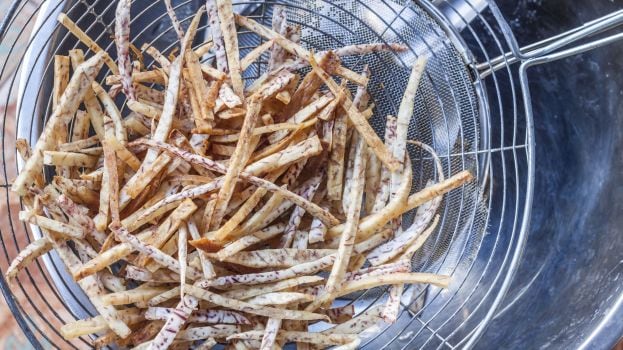Season for Tubers

In fact, colocasia is not just indigenous to India but to large parts of eastern Asia as well. In the Philippines, it goes under a name similar to our arvi/arbi — abi, and is a popular veggie. Besides, of course, it’s most popularly used as taro everywhere.The potato made its appearance in this part of the world only during colonial trade — the Dutch introduced the crop in the Philippines in the 16th century, from where, it gradually migrated to India only by the late 18th century. For years, after its introduction, it was regarded as a novelty, foreign veggie, used in food that was served at parties.10 Best Potato Recipes
In its stead, colocasia was always the go-to vegetable in homes. The aloo-meat curry, one of the most basic ways of combining goat meat and potatoes in a spicy thin gravy in northern India may be deemed “home-style” today, but it was quite likely to have been preceded by arbi-meat curry as the original protein-starch combination.Fried colocasia fingers make for an interesting textural counterpoint in this style of gravy dish, popular in UP, primarily in Muslim but also Kayastha homes.Beyond the Obvious: Delicious Regional Monsoon Treats from Across the Country

The favoured way to cook the tuber is, of course, to fry it. Since colocasia is also a monsoon ingredient, this makes sense given the fact that the Indian kitchens, whose functioning was based in Ayurveda, preferred a switch to “heat-inducing” foods gradually as the monsoon cooled the Subcontinent and to fried foods to keep diseases at bay.(Recipe: Arbi ki Kadhi)That is also perhaps why arbi and ajwain make for such a perfect marriage. Ajwain or carom is known for its digestive properties; it makes perfect sense and a perfect recipe to use the “monsoon” spice, warding off stomach infections common this time of the year, to coat fried colocasia.

We of course know that colocasia is an invaluable source of dietary fibre. The corms have more calories than potatoes, and these come primarily from complex carbs, which are slow digesting, will thus help fill you up more and also help elevate blood sugar levels gradually — unlike simple, easy-to-break down carbs.

Like its cousin, colocasia is also trending as an ingredient, especially at “modern” Indian food establishments. Arbi Tuk, for instance, has suddenly made an appearance on many menus, including at The Bombay Canteen in Mumbai, pegged on local gastronomy and a reinvention of forgotten Indian regional recipes.
The recipe is essentially the same as followed in many parts of UP as well, where, one other essential spice is added to the crispy arbi — ajwain. It elevates the dish to another level.Notch Up the Tang: Amchoor or Raw Mango Powder, the Summer CoolerIn Punjabi-influenced cooking, arbi may of course be cooked in a generic onion-tomato masala. But its charm can be better appreciated if you use the spices discerningly, and selectively. Dried fenugreek is another ingredient than goes well with the ingredient. Pan-roast the veggie and then coat it with a masala that includes a whiff of kasoori methi. You won’t forget the flavour.Disclaimer:The opinions expressed within this article are the personal opinions of the author. NDTV is not responsible for the accuracy, completeness, suitability, or validity of any information on this article. All information is provided on an as-is basis. The information, facts or opinions appearing in the article do not reflect the views of NDTV and NDTV does not assume any responsibility or liability for the same.








